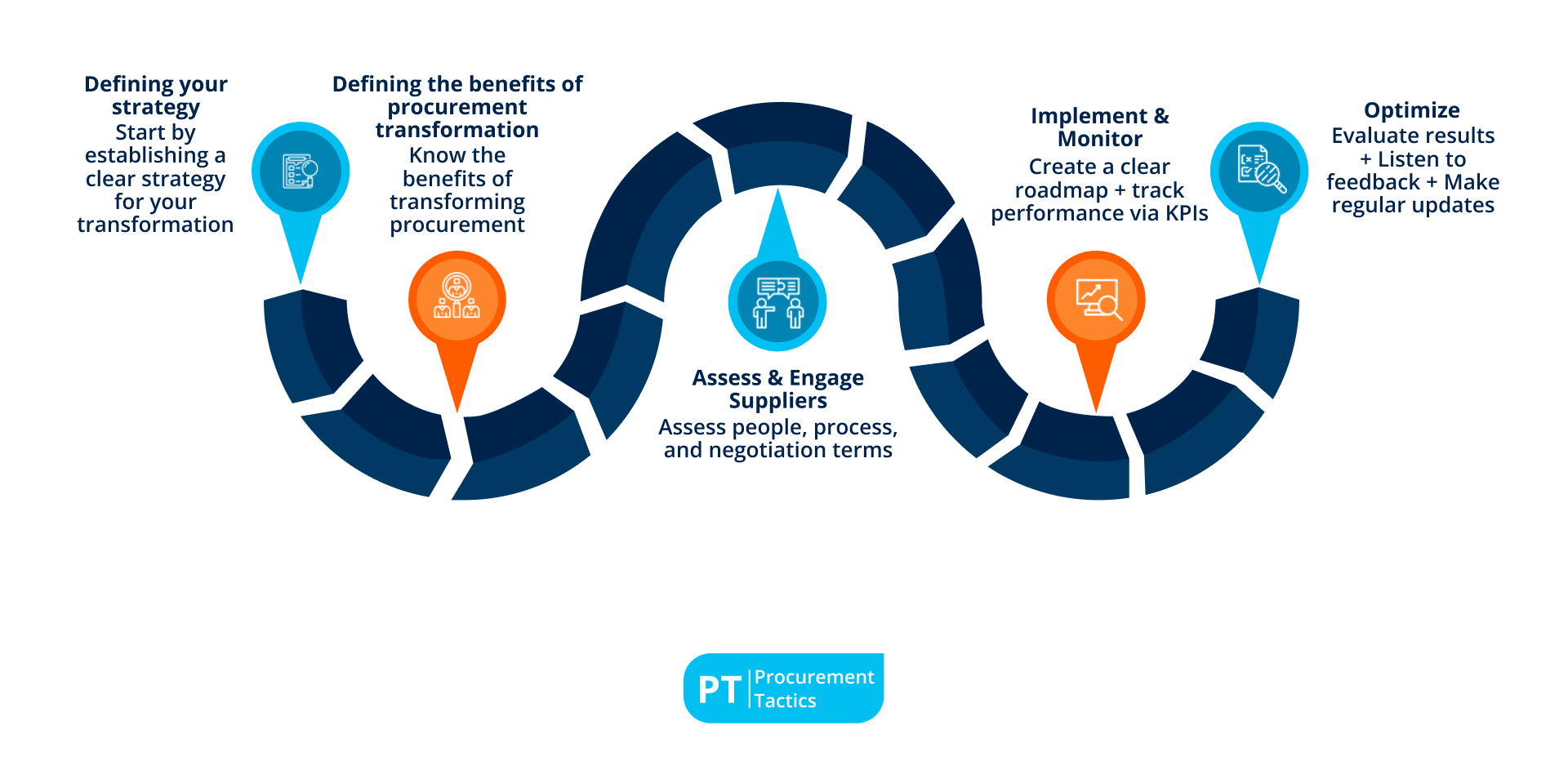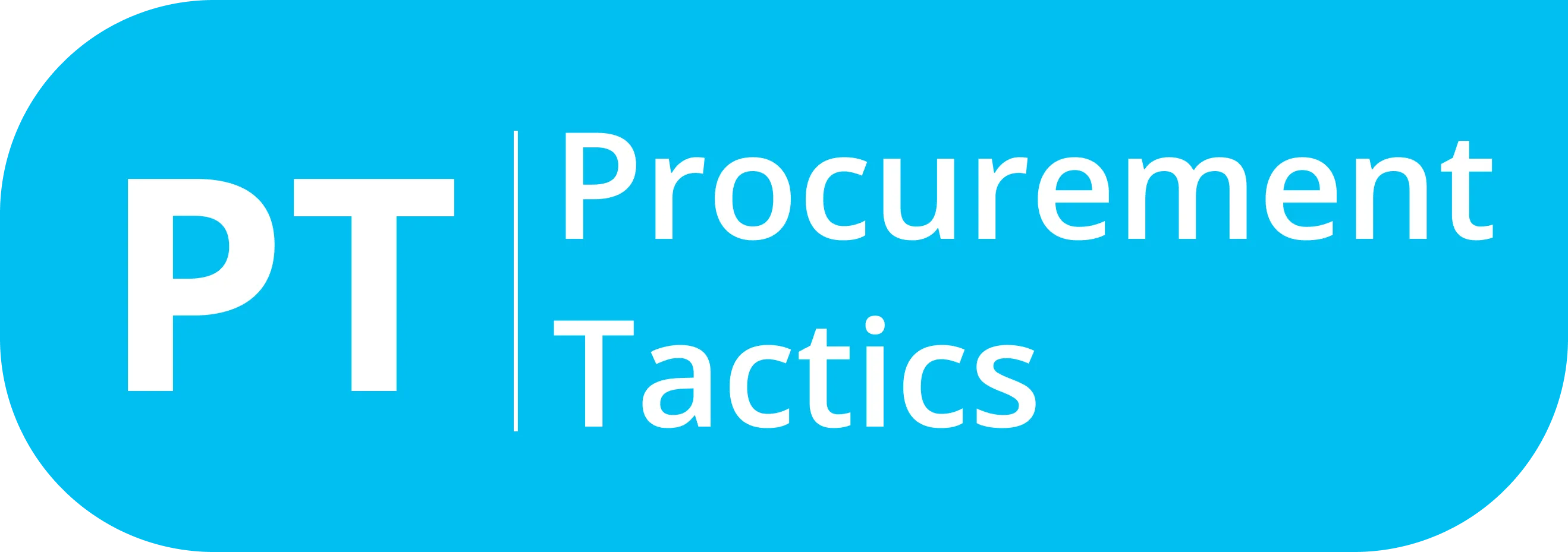Written by Marijn Overvest | Reviewed by Sjoerd Goedhart | Fact Checked by Ruud Emonds | Our editorial policy
Procurement Transformation Roadmap + Strategy 2025
What is a procurement transformation?
- Procurement transformation is the shift from the accustomed processes to strategic methods for procurement efficiency.
- Procurement transformation is important in shaping modern procurement processes.
- Procurement transformation enables organizations to optimize processes, strengthen supplier relationships, and achieve cost savings and increased agility.
What is Procurement Transformation?
Procurement transformation is the process of improving how an organization buys goods and services. The goal is to increase speed, reduce costs, and add more value.
During the pandemic, many organizations needed procurement teams to take on a more active role. As a result, procurement shifted from handling basic purchases to supporting business goals.
This change includes replacing old processes with faster and more flexible ones. It also involves using clear strategies to improve how procurement and supply chains work. The focus is on saving money and helping the business grow in a stable way.
Procurement Transformation Roadmap Explained
A Procurement Transformation Roadmap is a clear plan that helps organizations change their procurement functions. The goal is to move from basic, task-based work to a role that supports business goals and adds value.
The roadmap is not just about adding new tools. It supports changes in mindset, steps, and team structure. This allows procurement to help improve efficiency, support new ideas, and create long-term value.
The following steps are the road map that helps you for a successful procurement transformation:

1. Defining your procurement strategy
Start by establishing a clear strategy for your transformation. Ask yourself why your organization needs to transform procurement and what internal and external factors are driving this change. This step lays the foundation for all future actions by aligning procurement goals with broader business objectives.
2. Defining the benefits of procurement transformation
Once you define your strategy, it is time to know the benefits of transforming procurement.
The benefits that you can gain from transforming procurement are fewer disruptions, a resilient supply chain, enhanced risk management, and anything that can give value to the organization.
3. Procurement transformation assessment
In transforming procurement, you must know these three areas:
People – the most critical and valuable aspect of procurement transformation. You need to understand the current skill sets of your people. This will allow you to know if their skill sets are capable of achieving procurement transformation.
Process – you need to assess if your current process is aligned with the procurement transformation that you want. For example, if your goal is to improve customer experience, then a long process of approval will not cut it. For this, you need to ensure that the approval process will be simple and fast.
Technology – you need to have the right technology for the transformation to happen quickly. The goal here is to know the role of technology in your procurement transformation.
4. Know the scope of the transformation
You need to know the scope of the transformation to define what is covered and how long it will take to achieve it. The scope needs to answer your role in the procurement transformation.
5. Technology-based transformation
Obviously, technology is the key to transforming your procurement. However, it needs time and investment. It is important to invest in technology to streamline the process of procurement transformation.
6. Building the roadmap
Create a clear, actionable roadmap to guide your procurement transformation. This roadmap must prepare your team for two types of change: continuous and crisis-driven.
First is continuous change. Procurement has changed significantly over time. Continuous change comes from ongoing trends like digitalization, sustainability, and globalization. Procurement must adapt regularly by staying informed and adopting new tools.
The second is crisis management. In times of crisis such as COVID-19, the war in Ukraine, or a ship blocking the entire Suez Canal, procurement must adapt immediately to the new situation.
No one knows what or when the next crisis will occur, and there is still much unknown regarding continuous change. In both cases, business results can be optimized when there is a strong and dynamic procurement team. Since the future is unknown, teams need to prepare for this.
To handle both, your roadmap must build three core capabilities:
- Skilled People: Ensure that you have a well-motivated team with the right knowledge, who stay up-to-date with their time, which means maintaining their network well and staying up-to-date, including knowledge of tools like ChatGPT/AI.
- Strong Supplier Relationships: A good example of this is during COVID-19. Almost the entire world experienced shortages (in stores) in many different categories such as toilet paper, soap, rice, and pasta. Having a good relationship secures more volumes than your competitors, resulting in relatively well-stocked shelves and ultimately a significant boost in market share.
- Accurate Data: An organization can make the right decisions only if its data is accurate and complete. If you know the exact product demand at each store, you can do two things: first, order enough stock; second, work with the supply chain team to send the stock to the correct stores.
Transformation happens in steps. You need a clear roadmap to track how long the process will take. This roadmap should list the required resources and timelines. It helps avoid disruptions during the change.
This roadmap solves problems like disconnected tools and slow processes. It helps procurement teams work more effectively and align with business goals. This makes procurement a strong part of the company that supports long-term success, even during changes.
For further guidance, you can download our own Procurement Transformation Roadmap template to start outlining your own Roadmap and path to transforming your procurement processes.
How to Build a Procurement Transformation Strategy in 7 Steps
A procurement transformation strategy builds on the roadmap by offering a clear and practical plan to achieve transformation goals. While the roadmap shows why change is needed and what it should achieve, the strategy focuses on how to make it happen. The strategy explains the method. It shows the actions procurement must take to become a value-focused function that supports business goals. This includes setting specific goals, gaining executive support, and aligning people, processes, and technology in one plan.
The key steps in executing a procurement transformation strategy are:
1. Assess the current state
Review existing skills, workflows, tools, and needs. Understand what works—and what holds things back.
2. Set a future vision and clear goals
Define how procurement should operate in the future. Align these goals with the company’s wider business plan.
3. Build a detailed roadmap
Choose the most important actions. Assign tasks, plan resources, and set up clear management and oversight.
4. Redesign how procurement works
Adjust roles, streamline processes, and improve decision-making to support a more strategic, efficient setup.
5. Use smart tools and automation
Bring in platforms for sourcing, analytics, and automation. These tools improve control, speed, and data insights.
6. Improve how suppliers are managed
Group suppliers by value or risk. Boost collaboration. Use clear rules for tracking performance and managing risk.
7. Keep improving over time
Track progress using KPIs. Listen to feedback. Make regular updates to keep the transformation on track.
Trends in Transforming Procurement
1. Emerging Technologies
Procurement teams use AI, machine learning, and automation to reduce manual work and improve accuracy. Generative AI is now used in sourcing and contract tasks.
Blockchain improves product tracking and supply chain visibility. Paired with IoT, it enables real-time monitoring.
Cloud systems are replacing on-premise tools, offering lower costs and better integration. E-procurement methods are now standard.
2. Strategic and Tactical Approaches
Procurement is shifting from cost control to value creation. Leading teams focus on supplier partnerships and innovation.
Joint tools improve supplier coordination and reduce risks. Diversity and sustainability are now part of supplier selection.
AI helps teams manage supplier risk, cybersecurity, and compliance. New laws support faster, more controlled processes.
Better tracking of tail and maverick spend improves savings and oversight.
3. Best Practices for Transformation
Simplified workflows lead to faster results and higher adoption.
Cross-team work improves data and supports decisions. Nearly half of CFOs now use procurement data in planning.
Ongoing training in AI, analytics, and digital tools is needed. Teams must also follow rules on ethics, sustainability, and security.
4. Key Challenges
Bad data weakens AI results. Clean, structured input is essential.
Cyber risks increase with cloud tools and third-party access. IT and procurement must manage protections together.
Digital skill gaps and resistance slow progress. Training and support are key.
Teams must juggle cost, rules, ESG, speed, and innovation. Clear goals and planning help.
New laws add pressure with more compliance demands.
5. Data and Examples
Automation has cut manual work by 40% and sped up issue resolution by 30%.
Generative AI drives transformation, backed by $1.3B in global investment.
84% of leaders plan to use conversational AI.
UK and U.S. reforms enable faster, simpler public procurement.
6. What’s Next
Procurement will fully digitize using AI, blockchain, and cloud tools.
Success depends on privacy rules, ethics, and skilled teams. ESG and diversity will remain part of sourcing decisions.
Conclusion
Through constant acknowledgment and drive to transformation, procurement has evolved rapidly. To put it more simply, this means that revolutionary shifts have changed an organization’s behavior in acquiring goods and services to ensure maximum value.
Moreover, you must understand how important it is to recognize its relevance to shaping today’s procurement to establish a smoother and more successful supply chain, and ultimately the best business operations.
Furthermore, one prominent procurement transformation effect is the way how businesses do their procurement processes and pursue business operations and transactions after the COVID-19 pandemic.
Frequentlyasked questions
What is procurement transformation?
It is a shift from the accustomed processes to strategic methods in making procurement efficient.
Do I need to transform my procurement?
Yes. Transforming your procurement will help you source and deliver the supplies promptly.
Is technology important in transforming procurement?
Yes. technology is the key to transforming procurement. With technology, procurement becomes fast and efficient with its processes.
About the author
My name is Marijn Overvest, I’m the founder of Procurement Tactics. I have a deep passion for procurement, and I’ve upskilled over 200 procurement teams from all over the world. When I’m not working, I love running and cycling.





